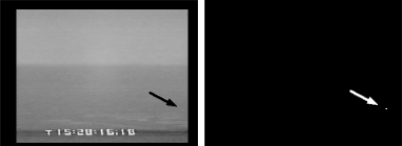|
|
 |

|
 |
 |
| Computer Vision for Aircraft Detection- Development of Algorithms for Obstacle Detection in Air-to-Air Images (Jeffrey W. McCandless, Albert J. Ahumada, Jr., & Mary K. Kaiser) |
 |
This project was part of the High Speed Research (HSR) program, which was dedicated to developing a supersonic aircraft called the High Speed Civil Transport (HSCT). The image processing component of the HSR program focused on collision avoidance for aircraft. The goal was to use computer vision technology to detect obstacles in video images taken from the nose of an aircraft. With this technology, pilots could be warned of the presence of nearby planes.
Since 1996, the Vision Group has been developing a series of C algorithms to detect other aircraft in the sky. These algorithms were tested on video imagery that was captured during flight tests out of NASA Langley Research Center. For these tests, a Kodak ES1.0 video camera was mounted on the nose of a Boeing 737 while a Beech King Air 200 flew in different trajectories in the vicinity of the 737. The images were recorded on S-VHS tape and digitized to a Silicon Graphics Onyx computer. A typical image recorded during the flights is shown in the left image. The distance to the target plane (indicated by the black arrow) is about one nautical mile, making it difficult to see in the image.
The algorithms for this project used three key steps for locating moving objects: first, video imagery from the nose of an aircraft was fed into the algorithm, then the optical flow in each frame was computed, then the optical flow was segmented into distinct components. The result of this approach was that independently moving objects (e.g., planes) could be located in the scene. The algorithm correctly located the Beech aircraft, as indicated by the white pixels at the end of the arrow in the right image. All other regions were displayed as black. We have developed a system to process the images in real-time.

Figure 1. The algorithm correctly located the Beech aircraft, as indicated by the white pixels at the end of the arrow in the right image. |
|
|
|
|